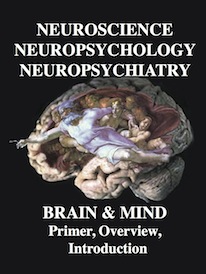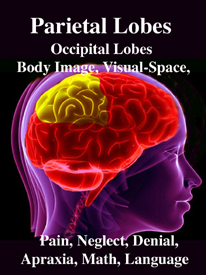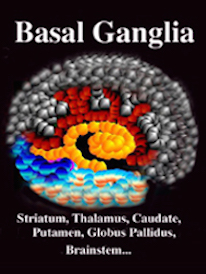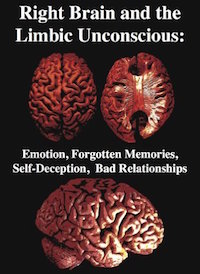Rhawn Joseph, Ph.D.
BrainMind.com
The genetic instructions for the creation of any and all living creatures is contained within DNA. For these instructions to be acted upon, however, generally requires an RNA intermediary. Originally, those RNA intermediaries may have been viruses
Specifically, RNA consists of a single thread of thousands of nucleotides and is manufactured as a single strand which is formed by only one half of the DNA helix. One of the two DNA strands forms a complementary chain of RNA. RNA, therefore, is derived from DNA and serves as a copy of the activated (coded) DNA which contain the genetic instructions for manufacturing various proteins, but differs from DNA not only because it is single stranded but employs uracil rather than thymine and its "backbone" consists of ribose rather than deoxyribose.
Once this information is copied, thus creating mRNA (messenger RNA), tRNA (transfer RNA) molecules detach from their DNA template and are dispatched on a cytoplasmic, intracellular journey where they search out, and bind with tiny micro-molecular enzyme manufacturing proteins referred to as ribosomes. Like greedy lovers the ribosomes and tRNA molecules embrace, thus forming rRNA (ribosomal RNA) which acts to code and express the information contained in copied DNA sequence segments. Once these instructions are decoded, specific proteins and enzymes are produced in accordance with the original DNA derived sources of genetic information. RNA, therefore, transfers these DNA-based instructions to the ribosomes so that they may be acted on thus producing the proteins necessary for building any and every body part, including multiple bodies parts or extensions of body parts thus inducing growth or change.
As there is absolutely no evidence to support the notion that DNA spontaneously or gradually arose from the muck of the Earth, some of those who embrace spontaneous/gradual generation have instead theorized that RNA may have been the first information bearing molecule to arise on this planet (Gilbert, 1986; Gesteland, 1993; Woodward et al., 1998). That is, life first arose in an RNA World.
In the hypothesized RNA-world, RNA creates DNA. In the real world, however, rather than RNA producing DNA, DNA serves as the template for RNA construction, and secretes and manufactures a variety of compounds (e.g. ATP, UTP, GTP, CTP) as RNA precursors. DNA specifies and provides the instructions for the synthesis of RNA and no RNA molecule can arise without these DNA-derived protein enzymes.
Some of those who believe in an RNA-world, however, reverse this process, and in so doing have had to reverse Crick's "Central Dogma," i.e. that information flows only in one direction, from nuclei acids to proteins (reviewed in Gesteland, 1993). In some RNA-world scenarios, DNA is dispensed with altogether and information changes course and flows from proteins to nucleic acids; a hypothesized function of the unusual chemical conditions that characterized the early Earth. This latter scenario, however, is unable to account for the existence of these initial proteins.
In yet other "RNA-world" scenarios, DNA is also dispensed with (at least initially) and this initial, hypothetical RNA molecule fashions the proteins which are responsible for the creation of RNA. More specially, in an "RNA world" rather than RNA being a product of DNA, this process is reversed, and a particular kind of ribosomal RNA acquires catalytic properties and begins producing proteins, and in so doing, eventually creates the first DNA (Gilbert, 1986; reviewed in Gesteland, 1993). Because DNA is a superior catalyst, these special ribosomal RNA then became subservient to these DNA molecules, and forever after have acted to code and transcribe DNA messages. Thus all subsequent life forms owe their existence to this primeval ribosomal-like RNA molecule.
As summarized by Robertson and Ellington (1998, p. 223), "Looking backwards from a contemporary vantage point, it seems that the RNA components of modern ribosomes, the cell's protein-synthesizing machinery, may itself be a ribozyme and thus a remnant of an RNA world. Looking forwards from origins, it is plausible that chemically simple, nucleic-acid or non-nucleic acid replicators gave rise to the raw material that became the RNA world."
This interesting scenario, however, does not appear to be tenable. RNA molecules are not alive, are exceedingly unstable, and cannot catalyze their own replication. Unlike DNA which can reproduce and give birth to itself -thereby creating genetic offspring- this is not a trait associated with RNA. Viruses, whose genomes consist of RNA are completely incapable of self-replication but instead must invade the genome of a host and literally hijack its DNA in order to reproduce; and this raises the possibility that viruses could have served as mobile RNA worlds. But that leaves open the question as to where and how did the first viruses evolve?
Although Bartel and Unrau report that they created "artificial ribozymes" capable of manufacturing one of the RNA bases, they in fact mixed trillions of organic molecules in a chemical solution, chose promising specimens, and then repeated the process again and again before creating an "artificial" ribozyme. What this means is that although an experimenter can experimentally mix and combine and chose certain organic substances so as to arrive at a carefully planned result, that the resulting, artificial molecule, nevertheless failed to create an RNA molecule.
Moreover, RNA is not easily accessed or recognized by proteins due to the depth and configurational organization of its nucleotide framework (Draper, 1995). Hence, it does not seem likely that even in an RNA-world that RNA would be able to generate the proteins and enzymes responsible for the creation of RNA or DNA.
It is noteworthy, however, that a specific type of RNA, ribozymes of which there are several subtypes (Herschlag, 1998) can be experimentally manipulated in a test tube or petri dish in order to engage in catalytic activities (Cech, 1986; Lamond & Gibson, 1990; Unrau & Bartel, 1998), including, with a little technical assistance, self-reproduction (Joyce & Wright, 1999). Moreover, Joyce and Wright (1999) reported that following several experimentally induced replications, "mutations" began to accumulate, which improved the likelihood of additional replications.
Since ribozymes can be experimentally manipulated in a test tube in order promote their own replication, and as they can act as a catalyst and can bind other molecules, these findings have been viewed as supporting the possibility of an RNA-world (Robertson & Ellington, 1998). Hence, via the assistance of ribozymes, it is theorized that RNA fashioned the proteins which give rise the first molecules of RNA, even though, on the early Earth, there was a scarcity of the necessary nucleotides that constitute RNA.
In order to solve the problem of the missing RNA nucleotides, Unrau and Bartel (1998), have presented evidence to support the argument that "RNA-based life must therefore have acquired the ability to synthesize RNA nucleotides from simpler and more readily available precursors, such as sugars and bases." Specifically, Unrau and Bartel (1998) found that if RNA molecules are extracted and isolated, that they can be experimentally manipulated to catalyze the synthesis of a pyramidine nucleotide. According to Unrau and Bartel (1998, p. 260), "the finding that RNA can catalyze this type of reaction... supports the idea of an RNA world that included nucleotide synthesis and other metabolic pathways mediated by ribozymes."
Of course, pyramidine is only one of the building blocks of RNA, and the RNA they employed to induce these reactions was experimentally manipulated and modified. If similar events occurred early in the history of the Earth, one might have to postulate the helpful assistance of the hand of god--or perhaps a well funded and equipped experimenter with a test tube. Moreover, these and similar arguments rests upon the notion that a ribo-organism and thus RNA-based life existed on the early Earth; a proposition for which there is absolutely no evidence (Robertson & Ellington 1998).
Moreover, even assuming that there existed RNA-based life, it not only had to have acquired catalytic abilities, but had to couple the nucleotides it created with sugars and sugar-phosphates so as to create a stable RNA-molecule. Moreover, as there were apparently no free-phosphates available, this RNA-based life had to either create phosphate where there was none, or extract it from minerals. And, most importantly, the theory of an RNA-world is rather circular in its reasoning, as it presumes the existence of an RNA-based life form that creates, with the assistance of ribozymes, RNA nucleotides, which RNA with the assistance of ribozymes, catalyzes to create RNA.
On the other hand, since the Miller-Urey-Calvin (and like-minded) experiments have generated some isolated RNA elements, this has led to the argument that early in the history of the Earth, the building blocks of RNA could have been fashioned, and these may have been randomly combined with fragments of RNA which rained down from the sky, thus creating the first step toward a ribo/RNA organism which spontaneous self-assembled.
For example, it has been demonstrated that if RNA-viral proteins are experimentally separated and then placed in a organic and chemical bath, these individual viral protein components and elements will spontaneously aggregate, recombine and will form a complete viral organism with wholly intact infective properties (Fraenkel-Conrat & Williams, 1955). Therefore, it is possible that viruses with RNA genomes may have served as RNA worlds. However, these viral-RNA's still require the DNA of a host organism in order to replicate, as well as the active hand of an experimenter in order to extract, isolate, and then bathe them together in a controlled chemical environment which has been purposefully manipulated.
Hence, even if a single RNA molecule did appear on Earth, for example, if it fell from the sky after being manufactured in a cosmic molecular cloud, even if it was already a fully formed viruses, it could not have engaged in self-replication as the necessary ingredients were nowhere to be found and as it would still require the DNA of a host organism in order to replicate.
As per the problems of self-replication and protein creation, some have argued that the first RNA molecule to appear on Earth (secondary to spontaneous/gradual generation) miraculously reproduced itself by somehow folding together in such a manner that identical base pairs became matched together (e.g. de Duve, 1995). This encircled RNA molecule then broke in half, or chopped itself into two identical copies. This self-mutilating RNA then began to replicate the severed segments thereby creating copies of itself. Of course, a process such as this requires a catalyst, a guiding hand, and DNA-based genetic instructions. In fact, RNA strands actually resist and are not amenable to becoming folded.
In summary, the theory of an RNA world, and the meager evidence which has been marshaled in support, fails to explain the origins of RNA, or ribozymes, or DNA, except through circular reasoning and through the creation of a theoretical chemical world--a theoretical world for which no evidence exists. Although numerous laboratories have attempted to prove otherwise, and although there has been some success in experimentally manipulating RNA and ribozymes so as to engage in catalytic and synthesizing activity, RNA cannot generate or make copies of itself (that is, without experimental assistance) and it cannot generate DNA. Only DNA produces DNA, and those cells (such as RNA equipped viruses) which are devoid of DNA are incapable of reproducing except via a DNA intermediary.
VIRUSES
Although the possibility of a life-creating RNA-world seems rather unlikely, some of the scenarios briefly mentioned above may well account for the creation of the first viral "organisms" (Joseph, 1997, 2000). RNA-based viruses may have served as mobile RNA worlds. Viral "organisms" however, are not truly organisms as they are not alive. Viruses generally differ greatly in size (from 10 to 300 nanometers), but are much smaller than single celled organisms including bacteria, approximating, in girth, a single protein or macro-molecule. (reviewed in Kuby, 1994). Viruses generally consist of a core of nucleic acid which is surrounded by cytoplasm containing lipids and carbohydrates, which are stabilized by a thick protein coat or lipid membrane. Almost all viruses store their genetic information in either a single or double strand of RNA with only a relatively few viral strains having acquired a single strand of DNA.
The viral genome is incredibly complex. In some cases, up to four genes are involved in regulating viral gene expression and protein synthesis. Nevertheless, although viruses have an RNA- and sometimes a DNA-genome, they share few of the metabolic and reproductive properties characteristic of animals, plants, or bacteria. Viruses behave more like a crystalline, or protein compound than a true living creature. That is, viruses are not really alive but instead consist of metabolically inert nucleoprotein particles that are in all respects lifeless. Viruses remain inert and lifeless until they come into contact with living cellular tissue, at which point they become mobile and invade and infect the host cell, sometimes inserting their own unique genetic messages into the DNA of their host (reviewed in Kuby, 1994).
Given the structure and organization of viral particles and their RNA-genome it is not inconceivable that they may have been produced -on this planet as well as others- via a process reminiscent of spontaneous generation. Viruses may be the imperfect result of the random mixing of organic sludge on any number of moons and planets. Because they have been imperfectly created, they are not alive, and thus require the complex internal environment of a living cell, and its DNA, in order to replicate.
As the viral genome may consist of only RNA or only DNA, viruses are incapable of self-replication but require a living alternative. Viruses are unique in that they require the DNA and the reproductive machinery of the host organism in order to reproduce viral DNA, and in order to replicate and to duplicate; thus, infecting the DNA of all host cells in the process. Although RNA viruses could have served as intermediaries in the establishment of life, they would have still required the existence of at least one strand of DNA to begin replicating.
In general, the virus will attack and attach its viral tail to the body of the host cell. This tail then secretes an enzyme which can digest part of the cell wall so that the virus can slip in and inject its own DNA or RNA into the cytoplasmic contents. The viral DNA/RNA attaches to the host chromosome, inserts itself into a gene, and then begins to direct the host cell's DNA/RNA so as to produce viral proteins and viral DNA. Viruses, therefore, are capable of inserting their RNA/DNA into the DNA of their host and altering the host's genome and sometimes splitting chromosomes in two (Berkner, 1988; Moss et al. 1990; Strachan & Read, 1996; Watson et al. 1994; Wigler, et al., 1979).
Once invasion and incorporation are accomplished viruses exert drastic influences on host cell metabolism and enzymatic machinery. Viral proteins and particles are rapidly produced, swelling the host cell until it bursts, thereby releasing its viral contents which then attack adjacent cells, exponentially multiplying, and sickening and sometimes killing the host in the process (reviewed in Kuby, 1994; Watson et al., 1992). HIV, smallpox, measles, rabies, polio, warts, fever blisters, the flu, and the common cold are all secondary to infective, invasive viral elements which take over the host cellular genetic machinery and rapidly divide.
Moreover, viruses have the capacity to become dormant following infection, and can be passed on to subsequent generations and even subsequent species. For example, the human genome is riddled with thousands of endogenous retroviruses which have been inherited and then passed on from old-world primate ancestors (Johnson & Coffin, 1999). In fact, these proviral elements can be employed to make estimates as to species phylogeny, as based on changes in ancestral sequences and their molecular evolution.
As noted, the viral genome is incredibly complex. The RNA of an influenza virus may consist of over 10,000 nucleotides, the order and arrangement of which contains the code for creating over a dozen different proteins. Likewise, the DNA of a single parovirus is composed of a double strand of base pairs which is 5,081 nucleotides in length (Watson, et al. 1992).
Presumably, it is because of the unique organization of their RNA (and sometimes DNA) based genome, that some viruses attack only special types of cells or specific organisms. HIV, for example, infects just three types of cells, dendritic cells, macrophages, and T lymphocytes which carry the CD4 receptor and serve the immune reaction (reviewed in Kuby, 1994).
As noted, viruses may have been created in a primordial organic soup following extraterrestrial contamination. Thus, they may have originated on Earth, as well as other planets and then acted as a bridge between non-life and DNA-based life. In fact, because viruses are lifeless as well as resistant to severe heat, cold, drying, alcohol, and even formaline solutions, they are perfectly suited for a life drifting in interstellar space, convalescing on some meteorite or cloud of stellar gas, dormant and lying in wait, like a spider, for a planet swarming with a variety of unsuspecting host cells. In fact, the demographics and patterns of contagion of various viruses, including some flu viruses, raise the possibility that in some cases, viral invasion may be secondary to the Earth passing through areas of outer space congested with viral organisms.
Moreover, although they may sometimes originate in interstellar space, thereby subjecting the peoples of the Earth to repeated epidemics, viruses, including prehistoric viruses between 500 and 140,000 years old, have been found, lying dormant, in the polar ice caps and from sites in Greenland (Starmer, Rogers, & Castello, 1999); which in turn suggests that they also lay dormant in other snow bound regions. According to Alvin Smith, a virologist at Oregon State University, "If you've got these things lying in the ice for a thousand years or more and their usual host has not had to deal with them, this may be a source of epidemics." Presumably, as the ice melts and as temperatures rise and the ice melts, these viral particles are released into the atmosphere thereby giving rise to epidemics. Indeed, viruses have found in fog and clouds.
Nevertheless, regardless of their source, viruses (like some bacteria) are capable of injecting their genetic material (and the genetic material of other species) into hosts cells, and may well be capable of drifting from planet to planet, thereby contributing to interplanetary gene exchange. Indeed, these globe trotting viral organisms may have contributed to the exchange and sharing of genetic/DNA memories not only between different host organisms, but between creatures living on wholly different planets thus promoting evolutionary metamorphosis (Joseph, 1997).
In summary, if we accept the premise of an RNA-world, it would appear that at best the end result would be the formation of an imperfectly created RNA molecule, which became a viruse which became a mobile RNA world. However, these RNA-entities, like viral organisms, could not have given rise to DNA, and would have been unable to replicate without the assistance of various DNA-based life forms (such as a human experimenter). However, as to the young Earth, these DNA-based life forms must have first "evolved" on other planets. As only DNA begets DNA and as the young Earth was devoid of this essential ingredient, we must conclude that the first DNA to appear on this world, must have been astro-biological in origin.
















